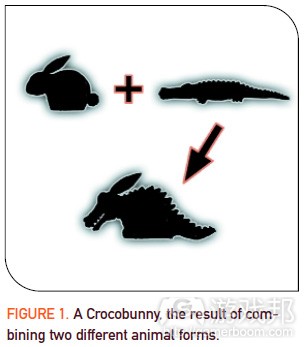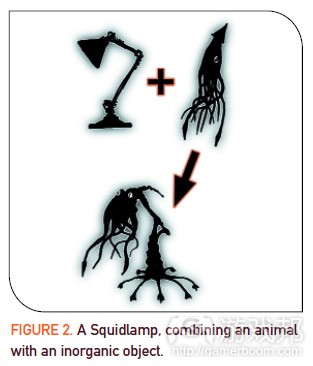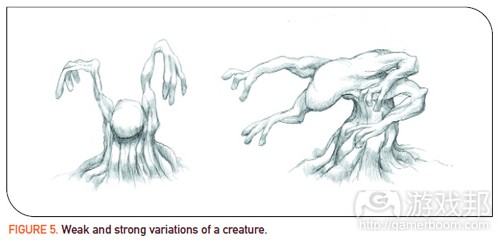开发者分享怪物设计的实用技巧
作者:Hayden Duvall
当我还年轻时,我从来没有为画画起稿犯过难。也许是因为年轻时想象力比较丰富。但随着年纪增加,我经常对着空白的画布不知所措。
面对空白的画布,我发现我的创意源泉似乎枯竭了,我胡乱涂画了几个小时,最后被迫放弃了。
作为美工,当我们“在状态”的时候,灵感就像火山爆发一样喷射出来;但在与这种兴致高昂的状态相反的时候,我们似乎面对桌上空白的画纸,茫然不知该拿什么东西填充它。就像写作障碍,这是可能使画者遭受无尽折磨的灾难;如果拖延得太久,宝贵的时间就被浪费了。
过去这几年,美工们开发出许多克服作画障碍的方法,以下是我觉得比较实用的一些方法,特别是对于怪物设计。
物种进化
游戏本身可能需要某些怪物发生一定程度的进化。然而,即使进化过程不是游戏的一部分,用进化的思路来设计怪物却是很有意思的。
如果时间不是大问题,你可以选择列举非常多的进化步骤,从最简单的物种想象出它进化成的有智能的后裔。如果时间比较紧迫,你可以拿出你以前画的草图,尝试进化的思路,看看会得到什么结果。
为什么使用这种方法?进化背后的主要思想,不是简单地画出物种的翻版,而是迫使美工思考物种生存的世界以及这个物种的特征。研究物种有什么特殊习性和如何适应周边环境,可能非常损脑细胞,但游戏世界及其居民的连贯性可以增加玩家的沉浸感,同时也提升视觉品质。你甚至可能给那些环境比较相似的区域留下角色设计和资源。
你也可以使用相同的进化原理制作更原始的物种。你可以使用这些更原始的物种来补充主要物种已经设计好的区域,以增加这些区域的连续性。
物物碰撞
有时候,最疯狂的想法正是最管用的。当他生气时,他就会变成一个绿色皮肤、肌肉发达的怪人,这本不可能成为什么了不起的设计,即使是在漫画书中。谁能想到,一款让玩家看到半自主的角色接受简单的命令后就会模仿日常生活、给角色购买新家具的游戏,会卖得比《圣经》还火爆?
所以,本着这种疯狂发明的精神,另一个怪物设计的思路就是组合两种没什么关系的东西,变成杂种。
以下是一些案例:
动物组合。这似乎是一个很普遍的做法,但增加一些想像力和其他人的帮助,仍然值得一试。基本上,你只需要两组动物(事实上是任意物物),最好是由不同人创作的图像。接着,你把这两组动物匹配起来,画出组合后的动物。
显然这是可能是一个无趣的过程,如果这两组动物设计不太有想象力的话,但多费点功夫,还是能得到比较有趣的结果的。图1就是采用这种方法得到的“鳄鱼兔”。
极端的动物组合。这一次,你的第二组“动物”可以是任何你能想得到的东西,而不局限于真正的动物。有时候,生物与生活用品的模糊组合也会管用。图2是这种实验产生的“乌贼灯”。
抱团设计
抱团设计法相当流行,其形式有若干种。最直接的一种是一队美工自己先画出怪物,然后把自己的设计交换给另一位美工,由这位美工继续设计,直到完成。
想法和风格的混搭产生的结果,通常滑稽多过实用,但如果设计实在遇到瓶颈,这也是值得一试的方法。
善恶相伴
怪物设计还可以采用善恶相伴的思路。先画一个看起来无毒无害的怪物,然后再使它变得邪恶。突出它的侵略性特征,如把牙画得更尖、爪子更利、眉头更低,增加尖刺等——这些东西可以产生邪恶的效果。在《Black & White》中,把驯服的家畜(游戏邦注:比如温顺的奶牛)变得邪恶的。这种做法通常很有趣,如果一开始的动物特别可爱或憨厚的话。
也可以反过来把邪恶的怪物变成友善的、无害的怪物,这也是很有趣的过程。对此,通常使用已经出现在电影、书籍、电视等媒体上的怪物作为初始怪物,因为这些设计已经是邪恶的典型了。例如,把《异形》中异形或《指环王:双塔奇谋》中的Uruk-hai变得可爱好玩。这就好像把别人的设计一层一层地剥离,但如果做得好,可能产生完全原创的怪物形象。
玩转比例
我讨厌蜘蛛,即使最坏的蜘蛛能做的事也不过是在你面前的地板上爬过去。当凑近看到这家伙那丑陋的眼睛、毛和牙时,我很庆幸自己不是只有半厘米那么高。昆虫世界和显微镜下的生物是怪物设计的灵感宝库。
我们大部分人都看过昆虫的电子显微镜图像,比如尘螨和小寄生虫。这些小东西基本上长相怪异甚至相当吓人。把它们放大到狮子或大象的尺寸,是一个怪物设计的好办法,只要有参考图像就行了。有时候,最好适当修改这些小家伙,比如去掉触角、把下颚换成普通的下颌,使它们更不像昆虫而更接近哺乳类。
逆向使用这个思路却往往不太成功。大动物(不像显微镜下的动物)的识别度太高,例如小犀牛并不怎么有意思。通常来说,游戏很擅长表现人类常见的动物。就这一点来说,把大动物变小,通常不会产生什么好结果。
面容分布
制作新的、有趣的怪物不只是在初始设计上进行。当你对设计的某些元素满意时,或当你有了一个你觉得可行的想法时,你还可以对你的设计做小规模的修改,以改善它。
例如,你可以使用面貌位移的方法。考虑一下面容:长相隐含着我们对角色或怪物的特征的理解。
上图中有三张脸,五官都是用相同的线条来表示的。第一张脸表示正常人类的面容;中间的脸五官缩成一团,突出了它的下巴,给人一种低眉头的感觉;最后一张脸的前额非常高。粗略说来,我们往往认为长着第二张脸的那种人或动物比较低智商,而第三张的则是高智商。
虽然面容分布的确切意义可能对某些设计并不重要,但有时候还是值得一试的,也许能把相同的基本设计变得更好。从图4你可以看到眼睛公位置的变化如何改变怪物的形象。
还有呢?
大哥小弟。无论是使用自己以前做的设计还是别人的设计,最好能做出大小不同的两三个版本。这里说的大小不只是外形上的大小,还有怪物成长的三个不同阶段,假设你的怪物有成长中期的话。另外,如果资源允许,相同的怪物有三个阶段的变体也可以增加游戏的深度,特别是如果动画和声音也能反映出这三个阶段。
随机词生成器。音乐有时候可以在你的头脑中产生视觉印象,词也是可以的。使用网上的随机词生成器,根据随机生成的怪物名称做设计。
弱和强。记住这个与善恶类似的概念。给相同的怪物做两个变体:一个虚弱无力,一个强壮吓人。图4就是使用这种反差得到的结果,蛮有效的。
食物链。制作一个从低端走到最高端的食物链(完全是想象的)。如果你严肃地对待这个食物链的话,你应该考虑到物种的习性、使前者能捕食后者的生理机能等。
增加四肢。给怪物添加额外的脚、手等。不过要重新调整它的身体重心,这样才不会显得你是为了添加四肢而添加四肢。
从海洋到陆地。选择一种只生活在深海的动物,把它变成陆地动物,也许会有不错的效果。
剪影或轮廓。你可以个人或在团队中实验这个技术。画一个怪物剪影(或轮廓),然后填充细节。一开始就画出精细的怪物是令人畏惧的任务,但先画剪影或轮廓再补充细节就容易多了。轮廓体现了怪物的重量和基本形态,你可以慢慢添加你认为必要的细节。
在实践中这些方法不一定总是管用,但适当使用,可以使单个设计的元素变得有趣或深刻。也许可行的结果就会慢慢成形。
有时候,创意与行业、方法和寻找有助于具体化想法的方法和在新方向上寻找这些方法有关。说到底,你越是勤快,你对着空白的画纸等待灵感的时候就越少。(本文为游戏邦/gamerboom.com编译,拒绝任何不保留版权的转载,如需转载请联系:游戏邦)
Stuck on that creature design? Here are some helpful techniques
By Hayden Duvall
As a young child, I never once remember having any trouble starting a picture. Perhaps it was the rampant imagination of youth, but as I have become older, I have often fallen victim to the Curse of the Blank Canvas.
Faced with nothing but empty space in front of me, I find it difficult to kick-start my creative juices (if indeed juices can be kick-started), and I scribble junk for hours until I’m forced to give up and skulk away into a dark corner, defeated.
It is true that as artists, we are sometimes in “the zone,” and creativity explodes from us like lava from Mount St. Helens, but the reverse of this elevated state seems to be the great white void that occasionally finds form in empty sheets of paper that stare blankly at us from our desk, daring us to fill them with something worthwhile. Like writer’s block, it is an affliction that can cause the sufferer no end of torment; valuable time can be wasted if it drags on for too long.
Artists over the years have developed many approaches to help keep the ideas flowing, and what follows are some of the methods I find useful, specifically when dealing with the area of creature design.
Evolving
The game itself may require certain creatures to evolve in some way. However, even if the evolution process isn’t part of your game, the design aspect of evolving a creature can lead ideas in interesting directions.
If time is not too much of an obstacle, you can choose to illustrate as many evolutionary steps as you wish, starting with a quite simple creature and evolving it into an imaginary, intelligent descendant. If you’re more pressed for time, you can perhaps take a sketch you have worked on previously and attempt to evolve it an extra step, seeing where that takes you.
Why bother with this approach? The main thinking behind evolving something, rather than simply drawing another version, is that this process forces the artist to think about the world within which the creature exists, as well as the specific characteristics of the creature. Looking at how a creature works in its particular habitat and how it could change to better adapt to its surroundings could seem like design overkill. But coherence of a game world and its inhabitants can add to the player’s immersion, while also upping the level of visual quality. You may even be left with a few creature designs that can be used, resources permitting, in areas where the environment is reasonably consistent.
You can also use the same principles you’ve used in the evolution process to work backward toward a more primitive life form. You can use these more primitive characters to populate parts of a world where some of the principal character design has already been done, in order to provide more consistency in those areas.
Collision
Some of the craziest ideas often seem to be the ones that catch on. A man that turns green and sprouts an insane amount of muscles when he gets angry can’t have been a completely straightforward pitch, even in the world of comic book heroes. Who would have thought that a game that lets players watch semi-autonomous characters mimic the mundane tasks of everyday life while they give them simple commands and buy them new furniture would practically outsell the Bible?
So, in the spirit of mad invention, another method for generating ideas for creature design involves the juxtaposition of two (or more) unconnected ideas, which then need to be absorbed into a single compound creation.
Here are some example methods to start the ball rolling:
Animal combinations. This is pretty much as it sounds, but with some imagination and a bit of help from someone else, it can be worth a try. Essentially, you need two lists of animals (any living creatures, in fact), preferably created by two separate people. These lists are then paired up and you attempt to draw the resulting creature combinations.
This can obviously be dull if the two lists aren’t that imaginative, but with some work, you can achieve interesting results. Figure 1 shows a “crocobunny” conceived through this process.
Extreme animal combinations. This time your second list is of any object you can think of, not just animals. Sometimes the obscure collision of a living creature with an everyday object can work. Figure 2 shows a “squidlamp” that resulted from one experiment.
Group Design
The group design approach is quite popular, and can take several forms. The most straightforward method is to have a group of artists begin drawing a creature, and after a short period pass their work to the next artist who then continues it, and so on until the creatures are complete.
This mixture of styles and ideas is often more hilarious than useful, but it can certainly help shake things up if they have become stagnant.
Good and Evil
As most famously illustrated in a game context with Lionhead’s Black & White, creature designs can be modified along the lines of good and evil. After starting with a creature that looks harmless or benign, the process of making this creature look evil can yield interesting results. Exaggerating aggressive features such as teeth and claws, lowering the central brow area, adding gratuitous spikes — all these methods can create the effect of evil. In Black & White, the use of a domesticated farm animal (a cow, the very essence of friendliness) made a great starting point for turning it evil. This process is usually most interesting if the point of departure is especially cute or fluffy.
In contrast, redeeming an evil creature to reverse the process and make it look friendly and harmless can also be good fun. The best starting point for this procedure can often be creatures that are already present in films, books, TV, and so on, where plenty of quality time has already been put into designing the very epitome of menace. Try, for example, to make Giger’s alien look cuddly, or the Uruk-hai in Lord of the Rings: The Two Towers look like they just want to sit down for a friendly game of chess. It may sound like ripping off someone else’s design, but if taken to extremes, the resulting creature is almost certainly going to be a completely original creation.
Playing with Scale
I hate spiders, and even though the worst a spider in the U.K. can do is run menacingly across the floor in front of you, when seen up close with all those eyes and hairs and giant pincerlike fangs, well, I’m just glad I’m not half an inch tall. The world of insects and microscopic creatures is a goldmine for interesting creature design ideas.
Most of us have seen electron microscope images of such things as dust mites and any number of tiny parasitic beasts, the majority of which are weird and incredible and often quite scary. Rescaling these creatures to the size of a lion or elephant can be an easy way of coming up with interesting-looking creatures that actually have reference photos from which to work. Sometimes, it will be best to adapt these tiny creatures somewhat, so that they look less insect-like and more mammalian, by removing antennae or replacing mandibles with a regular jaw.
The opposite scale process is usually less successful. Large creatures (unlike their microscopic counterparts) are very recognizable, and a small rhino, for example, isn’t exactly exciting. In general, a game world deals best with creatures that are around the player’s scale or above. In this respect, taking larger animals and shrinking them usually isn’t going to yield impressive results.
Feature Positioning
Creating new and interesting creatures isn’t just about the initial design ideas. Once you are happy with certain elements of your design, or once you have a specific idea that you feel works, there is plenty of scope for small-scale changes to refine your design.
For instance, you’ll have to address the issue of feature placement. Consider faces: implicit in our interpretation of faces are certain ideas about the character traits of the person or creature we are looking at.
Figure 3 shows three basic faces all made from the same lines. The top face represents normal human feature placement, the middle face has its features compressed to emphasize the chin and give the impression of a lower brow, and the bottom face has a significantly higher forehead. Crudely speaking, we are inclined to interpret the second of these faces as belonging to a person of lower intelligence, and the third as someone of higher intelligence.
While the exact meaning of where features are placed may not be that important for a particular design, it is sometimes worth experimenting with these features, to see if the same basic design can be improved by moving them. You can see in Figure 4 how, by changing the placement of the eye, you can change the interpretation of a creature’s personality.
Other Things to Try
Big brother, little brother. Using either a design you have already done, or an existing creature from another source, attempt to create both its big and little brothers. This is not a matter of merely making scale changes but extrapolating a design for a particular creature to three stages of its development, assuming that the starting point you have is the middle stage. Once again, resources permitting, having three age-dependent variations of the same creature can add depth to a game’s visuals, especially if animations and sound can also reflect these three states of maturity.
Random word generator. In the same way that music can sometimes create a visual impression in your mind, so can words. Using one of the random word generators on the Internet (this one, for example), attempt to derive a creature that fits a name generated at random.
Weak and strong. Keeping in mind the same concept as Good and Evil, create two variations of a source creature: one that is pathetic and weak, the other that is powerful and intimidating. Figure 5 shows how this use of contrast can be effective.
Alien food chain. Starting as low down as you like, create a food chain (entirely imagined) that leads to what would be an apex predator. If you take this food chain seriously (within reason), it should take into account such things as habitat, and include a physiology that would lend itself to catching and eating the creature that is one step below.
Additional limbs. Take a design and add extra legs, arms, or both. Rework it so that the creature is able to maintain a reasonable center of gravity, and so that it doesn’t look like you’ve just added extra limbs for the sake of it.
From the sea to the land. Taking one of the exceptionally bizarre creatures of the deep and transforming it into something that would survive on the land can produce interesting results.
Silhouette or outline. You can try this technique on your own or in a group. Draw a creature in silhouette (or just its outline) and then fill in the detail. This way you can avoid the sometimes daunting task of creating a whole detailed creature in one go. The outline describes its mass and basic form, and then you can fill in as much or as little of its features as you find necessary.
Even if you don’t always find these methods usable in practice, elements of the individual designs should stand out as interesting or worth pursuing. After a while, a workable result can begin to emerge.
Creativity is sometimes about industry, method, and finding ways to help crystallize ideas and explore them in new directions. Ultimately, the more industrious you can get, the less you’ll have to stare at a blank sheet of paper waiting for inspiration.(source:gamasutra)
上一篇:探讨动机心理学与游戏设计的关系
下一篇:解析游戏挑战的设计技巧和要求











































 闽公网安备35020302001549号
闽公网安备35020302001549号